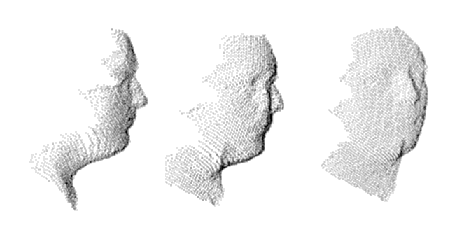3D_RMA : 3D database

0. Distribution
restrictions
The use of the "3D_RMA" database
recorded at the SIC is restricted to research purposes. The
(re-)distribution of the database - or part of it - either in original form or
modified is allowed only with the written permission of the concerned perons of
the database. However, any know-how gained thanks to the database may be freely
used and transmitted.
SIC distributes the
database subject to the acceptance of the above conditions. By reception of the
signed agreement,
SIC will give access to the files for download (tar.gz 13MB).
1. 3D acquisition
In the framework of our face recognition
activities, we developed at the SIC, a 3D acquisition system based on
structured light. With a projector and a camera, the facial surface is acquired
as a set of 3D coordinates. The quality and precision seems sufficient for this
first prototype. However, glasses and bushy or dark facial hair impair the
acquisition.
2. 3D Database
120 persons were asked to pose twice in front
of the system: in Nov 97 (session1) and in January 98 (session2). For each
session, 3 shots were recorded with different (but limited) orientations of the
head: straight forward / Left or Right / Upward or downard.
Among
the 120 people, two thirds consist of students from the same ethnic origins and
with nearly the same age. The last third consists of people of the academy, all
aged between 20 and 60.
Different
problems encountered in the cooperative scenario were taken into account. People
sometimes worn their spectacles, sometimes didn't. Beards and moustaches were
represented. Some people smiled in some shots. Small up/down and left/right
rotations of the head were requested. We regret that only a few (14) women were
available.
3. 3D format
Each 3D file, with extension '.xyz', is
organized as a set of 3D points along stripes. Each stripe starts with a short
integer indicating the number N of points in the stripe. Then N triplets of
short (signed 2-byte) integer give the point coordinates. The resolution is
Ex: 2 x y z x y z 3 x y z x y z x y z 2 x y z x y z
The
head is scanned (stripe order) from chin to forehead (increasing x) and the
stripes are scanned left to right (increasing y). Do mention that for technical
reasons, the camera/projector head was rotated about 40°, so that the X and Y
axis do not correspond to respectively the vertical and horizontal axis
anymore.
See
readXYZ.c for a read function in C.
4. Download
Click here to download the 3D database (13.4 Mb) in
gzipped tar file.
5. M2VTS
This
database has been acquired in the framework of the M2VTS
project.
Contact:
Signal and Image Centre (SIC) - Elec Dpt
Royal Military Academy of Belgium
30, avenue de
B
Face recognition: Charles Beumier (beumier@elec.rma.ac.be)
+32 2 742 66 67
Fax +32 2 742 64 72
http://www.sic.rma.ac.be